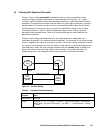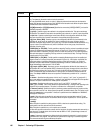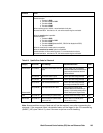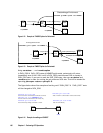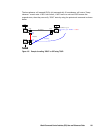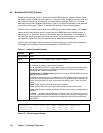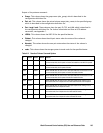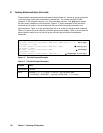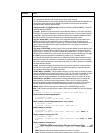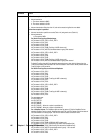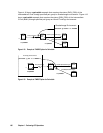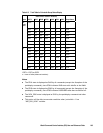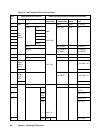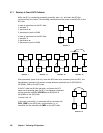
Hitachi Command Control Interface (CCI) User and Reference Guide 195
Parameter Value
Options -h: Displays Help/Usage and version information.
-q: Terminates the interactive mode and exits the pair volume check command.
-z or -zx (OpenVMS cannot use the -zx option): Makes the pairvolchk command enter the interactive mode.
The -zx option guards performing of the HORCM in the interactive mode. When this option detects a
HORCM shut down, interactive mode terminates.
-I[H][M][instance#] or -I[TC][SI][instance#] Specifies the command as [HORC]/[HOMRCF], and used for
specifying instance# of HORCM.
-g <group>: Specifies the group name defined in the configuration definition file. This option must always
be specified. The command is executed for the specified group unless the -d <pair Vol> option is specified.
-d <pair Vol>: Specifies the paired logical volume name defined in the configuration definition file. When
this option is specified, the command is executed for the specified paired logical volumes.
-d[g] <raw_device> [MU#]: Searches a group on the configuration definition file (local instance) for the
specified raw_device, and if the specified raw_device is contained in the group, the target volume is
executed as the paired logical volume (-d) or group (-dg). This option is effective without specification of “-g
<group>“ option. If the specified the raw_device is contained in two or more groups, the command is
executed on the first group.
-d[g] <seq#> <LDEV#> [MU#]: Searches a group on the configuration definition file (local instance) for the
specified LDEV. If specified LDEV is contained in the group, the target volume is executed as the paired
logical volume (-d) or group (-dg). This option is effective without specification of “-g <group>“ option. If the
specified LDEV is contained in two or more groups, the command is executed on the first group. The <seq
#> <LDEV #> values can be specified in hexadecimal (by addition of “0x “) or decimal notation.
-c: Checks the conformability of the paired volumes of the local and remote hosts and reports the volume
attribute of the remote host. If this option is not specified, the volume attribute of the local host is reported.
-ss: Used to acquire the attribute of a volume and the pair status of a volume. If this option is not specified,
the volume attribute is reported.
-nomsg: Suppresses messages to be displayed when this command is executed. It is used to execute a
command from a user program. This option must be specified at the beginning of a command argument.
The command execution log is not affected by this option.
-FHORC [MU#] or -FCA [MU#]: Forcibly specifies a cascading TrueCopy volume for specified pair logical
volumes on ShadowImage environment (see example in Figure 4.18). If no -c
option is specified, this option
acquires the attributes of a cascading TrueCopy volume on a local host (near site). If the -c option is
specified, this option acquires the attributes of a cascading TrueCopy volume on a remote host (far site).
-FMRCF [MU#] or -FBC [MU#]: Forcibly specifies a cascading ShadowImage volume for specified pair
logical volumes on TrueCopy environment (see example in Figure 4.19). If no -c o
ption is specified,
acquires the attributes of a cascading ShadowImage volume on a local host (near site). If the -c option is
specified, acquires the attributes of a cascading ShadowImage volume on a remote host (far site).
-MINAP: Shows the minimum active paths on specified group in HORC/HORCAsync on PVOL.
Note: If RAID F/W will not be supporting the number of active path, then “MINAP” item will not be displayed
as follows.
pairvolchk : Volstat is P-VOL.[status = PAIR fence = ASYNC CTGID = 2]
Display example for ShadowImage/Snapshot:
# pairvolchk -g oradb
pairvolchk : Volstat is P-VOL.[status = PAIR ]
Display example for ShadowImage (specified with “-m grp” option):
# pairvolchk -g oradb
pairvolchk : Volstat is P-VOL.[status = PAIR CTGID = 1]
Display example for TrueCopy:
# pairvolchk -g oradb
pairvolchk : Volstat is P-VOL.[status = PAIR fence = DATA MINAP = 2 ]
Display example for TrueCopy Sync CTG:
# pairvolchk -g oradb
pairvolchk : Volstat is P-VOL.[status = PAIR fence = DATA CTGID = 2 MINAP
= 2 ]
Display example for TrueCopy Async:
# pairvolchk -g oradb
pairvolchk : Volstat is P-VOL.[status = PAIR fence = ASYNC CTGID = 2 MINAP
= 2 ]
MINAP displays the following two conditions (status) according to the pair status:
PVOL
: This shows the minimum in Active Paths on specified group in TrueCopy/TrueCopy Async



